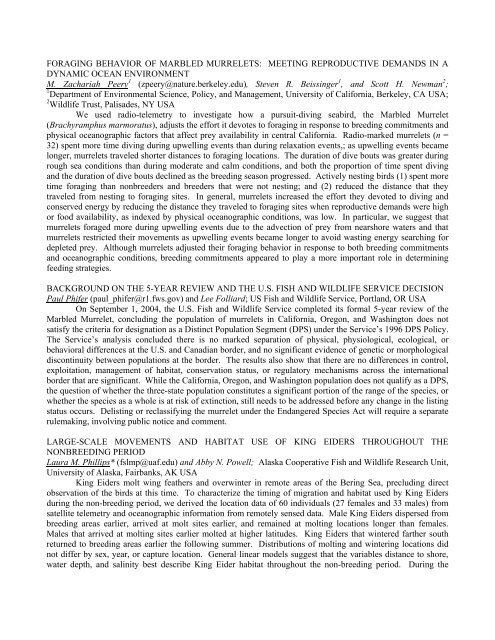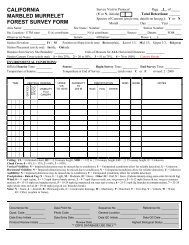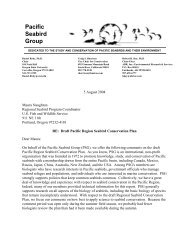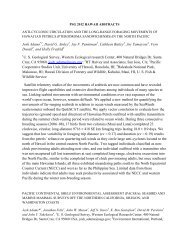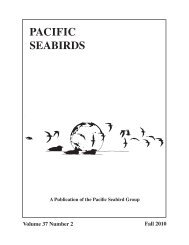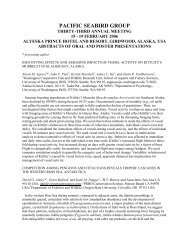abstracts of oral and poster presentations - Pacific Seabird Group
abstracts of oral and poster presentations - Pacific Seabird Group
abstracts of oral and poster presentations - Pacific Seabird Group
You also want an ePaper? Increase the reach of your titles
YUMPU automatically turns print PDFs into web optimized ePapers that Google loves.
FORAGING BEHAVIOR OF MARBLED MURRELETS: MEETING REPRODUCTIVE DEMANDS IN A<br />
DYNAMIC OCEAN ENVIRONMENT<br />
M. Zachariah Peery 1 (zpeery@nature.berkeley.edu), Steven R. Beissinger 1 , <strong>and</strong> Scott H. Newman 2 ;<br />
1 Department <strong>of</strong> Environmental Science, Policy, <strong>and</strong> Management, University <strong>of</strong> California, Berkeley, CA USA;<br />
2 Wildlife Trust, Palisades, NY USA<br />
We used radio-telemetry to investigate how a pursuit-diving seabird, the Marbled Murrelet<br />
(Brachyramphus marmoratus), adjusts the effort it devotes to foraging in response to breeding commitments <strong>and</strong><br />
physical oceanographic factors that affect prey availability in central California. Radio-marked murrelets (n =<br />
32) spent more time diving during upwelling events than during relaxation events,; as upwelling events became<br />
longer, murrelets traveled shorter distances to foraging locations. The duration <strong>of</strong> dive bouts was greater during<br />
rough sea conditions than during moderate <strong>and</strong> calm conditions, <strong>and</strong> both the proportion <strong>of</strong> time spent diving<br />
<strong>and</strong> the duration <strong>of</strong> dive bouts declined as the breeding season progressed. Actively nesting birds (1) spent more<br />
time foraging than nonbreeders <strong>and</strong> breeders that were not nesting; <strong>and</strong> (2) reduced the distance that they<br />
traveled from nesting to foraging sites. In general, murrelets increased the effort they devoted to diving <strong>and</strong><br />
conserved energy by reducing the distance they traveled to foraging sites when reproductive dem<strong>and</strong>s were high<br />
or food availability, as indexed by physical oceanographic conditions, was low. In particular, we suggest that<br />
murrelets foraged more during upwelling events due to the advection <strong>of</strong> prey from nearshore waters <strong>and</strong> that<br />
murrelets restricted their movements as upwelling events became longer to avoid wasting energy searching for<br />
depleted prey. Although murrelets adjusted their foraging behavior in response to both breeding commitments<br />
<strong>and</strong> oceanographic conditions, breeding commitments appeared to play a more important role in determining<br />
feeding strategies.<br />
BACKGROUND ON THE 5-YEAR REVIEW AND THE U.S. FISH AND WILDLIFE SERVICE DECISION<br />
Paul Phifer (paul_phifer@r1.fws.gov) <strong>and</strong> Lee Folliard; US Fish <strong>and</strong> Wildlife Service, Portl<strong>and</strong>, OR USA<br />
On September 1, 2004, the U.S. Fish <strong>and</strong> Wildlife Service completed its formal 5-year review <strong>of</strong> the<br />
Marbled Murrelet, concluding the population <strong>of</strong> murrelets in California, Oregon, <strong>and</strong> Washington does not<br />
satisfy the criteria for designation as a Distinct Population Segment (DPS) under the Service’s 1996 DPS Policy.<br />
The Service’s analysis concluded there is no marked separation <strong>of</strong> physical, physiological, ecological, or<br />
behavi<strong>oral</strong> differences at the U.S. <strong>and</strong> Canadian border, <strong>and</strong> no significant evidence <strong>of</strong> genetic or morphological<br />
discontinuity between populations at the border. The results also show that there are no differences in control,<br />
exploitation, management <strong>of</strong> habitat, conservation status, or regulatory mechanisms across the international<br />
border that are significant. While the California, Oregon, <strong>and</strong> Washington population does not qualify as a DPS,<br />
the question <strong>of</strong> whether the three-state population constitutes a significant portion <strong>of</strong> the range <strong>of</strong> the species, or<br />
whether the species as a whole is at risk <strong>of</strong> extinction, still needs to be addressed before any change in the listing<br />
status occurs. Delisting or reclassifying the murrelet under the Endangered Species Act will require a separate<br />
rulemaking, involving public notice <strong>and</strong> comment.<br />
LARGE-SCALE MOVEMENTS AND HABITAT USE OF KING EIDERS THROUGHOUT THE<br />
NONBREEDING PERIOD<br />
Laura M. Phillips* (fslmp@uaf.edu) <strong>and</strong> Abby N. Powell; Alaska Cooperative Fish <strong>and</strong> Wildlife Research Unit,<br />
University <strong>of</strong> Alaska, Fairbanks, AK USA<br />
King Eiders molt wing feathers <strong>and</strong> overwinter in remote areas <strong>of</strong> the Bering Sea, precluding direct<br />
observation <strong>of</strong> the birds at this time. To characterize the timing <strong>of</strong> migration <strong>and</strong> habitat used by King Eiders<br />
during the non-breeding period, we derived the location data <strong>of</strong> 60 individuals (27 females <strong>and</strong> 33 males) from<br />
satellite telemetry <strong>and</strong> oceanographic information from remotely sensed data. Male King Eiders dispersed from<br />
breeding areas earlier, arrived at molt sites earlier, <strong>and</strong> remained at molting locations longer than females.<br />
Males that arrived at molting sites earlier molted at higher latitudes. King Eiders that wintered farther south<br />
returned to breeding areas earlier the following summer. Distributions <strong>of</strong> molting <strong>and</strong> wintering locations did<br />
not differ by sex, year, or capture location. General linear models suggest that the variables distance to shore,<br />
water depth, <strong>and</strong> salinity best describe King Eider habitat throughout the non-breeding period. During the


